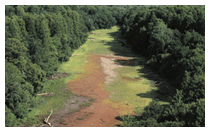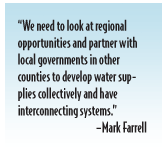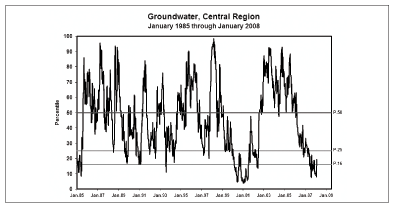 |
||||||||
Drought Reveals Good News, Bad News
By Victoria Parsons
 First, the good news: Tampa Bay is in better shape than anywhere else in the state as we head into what is likely to be a record-setting drought.
First, the good news: Tampa Bay is in better shape than anywhere else in the state as we head into what is likely to be a record-setting drought.
Now the bad news: All signs point to an extended dry period that will require extreme conservation efforts from residents and businesses and may damage important ecosystems that had been recovering from historical overpumping.
“We’ll never get to the point where someone turns on the tap and water doesn’t come out, but the environment may suffer,” said David Moore, executive director of the Southwest Florida Water Management District. “No community can build the infrastructure necessary to handle the worst drought, but Tampa Bay is a model for the nation because we’re fully utilizing surface, ground and desalinated water in a diversified supply system.”
The biggest fear, adds Granville Kinsman, manager of the district’s hydrologic data section, is what we’re facing now — a multi-year drought with no end in sight. Drought was first declared in January 2007, followed by a “rainy season” so dry that water levels continued to decline. 
The La Nina conditions we’re experiencing now typically mean drier than normal dry seasons, but it’s harder than ever to predict weather patterns, Kinsman said. “Rainfall patterns seem to be changing when you look at the historical record. There are huge swings that are completely unpredictable – I don’t put a lot of weight on long-term predictions but I have a bad feeling about this Spring.”
 |
| A River Ran Through It? The Withlacoochee dried to a trickle during the record-setting drought of 2001. Water managers are concerned that this drought may be even worse. |
October Showers Bring May Flowers?
Ironically, unpredictably high levels of rain in October 2007 put Tampa Bay in better shape than it had been all last year. Emergency orders allowed Tampa Bay Water to capture additional water from the Hillsborough and Alafia rivers so the Bill Young Reservoir started the year with nearly 11 billion gallons instead of the 6.3 billion stored in August. At its full capacity of 15 billion gallons of water, the reservoir can supply 25 percent of the region’s needs for more than six months.
 Tampa Bay also kicked off the new year with a long-awaited seawater desal plant operating at full capacity, providing 25 million gallons per day (mgd) or about 10% of the regional water supply.
Tampa Bay also kicked off the new year with a long-awaited seawater desal plant operating at full capacity, providing 25 million gallons per day (mgd) or about 10% of the regional water supply.
But the high levels of rain in October only highlight the fact that Floridians can’t count on Mother Nature to provide the water we need. “Droughts aren’t unusual,” says Mark Farrell, president of Water Resource Associates and a former water management district official. “They’ve happened in the past and they’ll continue to happen, particularly as we fill the state with more people.”
|
With alternative water sources built on a regional basis, water will be available – but costs will increase and conservation will become more critical than ever. “We need to look at conservation as a way of life, so that people know that living in Florida means water conservation year-round, not something that happens when we’re in a drought,” Farrell adds. “Lawns only need water once a week most times of the year, so why backtrack and confuse people with constantly changing messages?”
Infrastructure to capture and deliver new water also needs to be planned further out, on a 50-year plan rather than a 20-year cycle, Farrell said. “We need to consider this drought to be a message to all local officials – how are we going to fund all this new infrastructure? The needs will be enormous just maintaining and replacing the existing infrastructure as it ages.”
The inexpensive groundwater that still represents a majority of the region’s water supply can’t be tapped for increased growth. Alternative sources, like reservoirs and desal plants, are more difficult to plan and more expensive to build. “We need to look at regional opportunities and partner with local governments in other counties to develop water supplies collectively and have interconnecting systems, adds Farrell.”
 The technology to develop new water sources is available, but costs will continue to rise at a time when state and federal dollars are drying up. And even without current funding restrictions, managers will always be behind increasing demand. “We can’t build the infrastructure in anticipation – the demand has to be in place so we’re always going to play catch-up to meet it,” he notes.
The technology to develop new water sources is available, but costs will continue to rise at a time when state and federal dollars are drying up. And even without current funding restrictions, managers will always be behind increasing demand. “We can’t build the infrastructure in anticipation – the demand has to be in place so we’re always going to play catch-up to meet it,” he notes.
Natural Systems Slow to Rebound
As the drought continues, environmental impacts are likely to increase. Shrinking lakes, dried-out wetlands and creeks filled with weeds instead of water impact more than the wildlife that inhabits them year-round. Birds, like white ibis must feed their hatchlings food from freshwater sources because they can’t tolerate high levels of salt. Lower levels of rain also increase salinity in habitats where they live.

But as bad as it may look now, those ecosystems are accustomed to drought and are likely to recover, based on observations from the last drought in the spring of 2001. “Most lakes rebounded after about 18 months, but some took almost three years to recover,” Kinsman said. “It took time and lots and lots of rain – about 22 inches above normal rainfall – but everything did eventually come back.”
 |
| Groundwater levels across Pinellas, Hillsborough, Polk and Pasco counties show a dramatic decrease over the past two years when compared to historic norms, depicted as the 50 percentile line. In a year with normal rainfall, water levels are expected to decline through May but below-normal rainfall causes the steep drop shown on this chart. The long-term forecast still calls for below-normal rain through May which may break record levels set in January 2001. Graphics courtesy Southwest Florida Water Management District |
Back to Top



 ABOVE - Warning: drought A sign of the times, the Southwest Florida Water Management District has teamed up with local governments to urge conservation.
ABOVE - Warning: drought A sign of the times, the Southwest Florida Water Management District has teamed up with local governments to urge conservation.